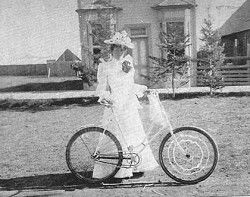History of Long Creek focus of ‘Starting Over’
Published 5:00 pm Tuesday, July 18, 2006

- <I>Photo from "Starting Over"</I><BR>An unidentified woman in front of Lillie Allen's millinery shop, downtown Long Creek, circa 1900.
Historical books are not my idea of fun reading, therefore, when “Starting Over” was assigned to review, I wasn’t happy. The only thing going for it was that it was about Long Creek, and I was curious about some of the events I’d heard allusions to.
With precision and thoroughness, author William Willingham uses historical demography to shape his analysis of how the Eastern Oregon West was won.
Through early American town studies, Willingham correlates relationships between family and kin and population changes, records from the county court, voting and office holding lists, tax, probate, church, and land records. He does this in such a way that the reader doesn’t sense information gaps in the history that is being presented.
“Starting Over” (Oregon Historical Society Press) covers the growth of Long Creek from around 1875 to 1925. Willingham weaves together the aforesaid records with information about political climate in Long Creek and national events that impacted on Oregon, and Long Creek in particular.
An excerpt from the Blue Mountain Eagle, 1909, writing about Long Creek describes it as; “a waving witchery of green, undulating in the summer winds like the surface of the sea.”
There are also many fun excerpts from local newspapers of the time. Grant County had six newspapers at one point. An excerpt from the East Oregonian says that: “The newspaper war in Grant County is more strenuous than the range wars of that county, with the additional sad fact that editors are not so plentiful as sheep there and it will take not so long to exterminate them.”
J.D Ashbury, editor of Eagle rival, The Grant County News, April 19, 1888, reported on former editor, Peter Connolly, of the Eagle, as a “cur, slanderer and blackmailer” and “an utter disgrace” to the profession of journalism.
According to the News editor, Connolly “came to Long Creek about three years ago, and introduced himself as, Three-card-monte-Pete, and a bad man from Five Points, New York,” and for a while subsisted by gambling with and robbing boys and men by his 3-card monte games.
In course of time, E.C. Allen bought a newspaper outfit, and associated himself with Pete-now known as “Peter the Poet”-in the publication of the Eagle, on which he carried on a regular blackmail on every person whom he could not control and lead his own way. Instead of publishing news of interest, he would lay around the saloons and gather the vulgar conversations of different person, and publish it as “legitimate local news.”
Willingham shows through records and personal interviews how the Oregon west was won, the trials and tribulations of the early homesteaders, gold mining and claim jumpers, Indians ranging over the hills looking to survive on camas, rustlers and thieves, bawdy houses and saloons, the Chinese population and how they were treated.
An editor from The Grant County News in 1885, describes local sentiment about the Chinese population; “To everyone it is apparent that the Chinese are a curse and a blight to this country, not only financially, but socially and morally; and but for their presence to-day, the Pacific Coast would be peopled with a different class of laborers-white men, willing to settle down and make their home among us. What the Chinaman wears, he brings with him, and what he eats, (except rats and lizards) he brings across the ocean.”
The book was packed with solid information and hard to put down. The author exposes the shared social values of the settlers, their religious affiliations, and local organizations and kinships.
Altogether, thought-provoking. Not only because it covers one of our own little communities and reveals its establishment and growth, it also demonstrates the courage, strength and convictions of the people that made Grant County what it is today.
William F. Willingham is a public historian who lives in Portland. He is the author of six previous books.




